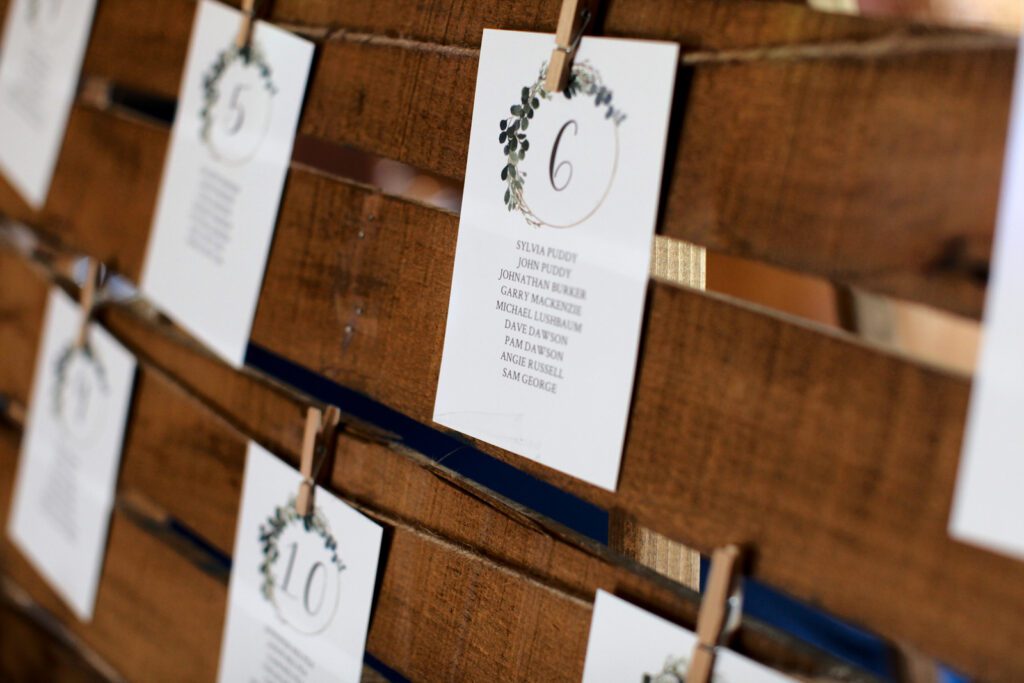When it comes to wedding planning, the details make all the difference. One of those details is how you decide to guide your guests to their seats at the wedding venue reception. Should you go with traditional wedding seating cards, wedding place cards, or a wedding seating chart? Maybe you’re looking for the latest seating wedding trends. This article will help you compare the advantages and disadvantages of each option, ensuring that your wedding reception seating is as well-organized as the rest of your special day. Understanding Your Seating Options
Understanding Your Seating Options
Before we delve into the specifics of each option, let’s clarify what we’re talking about:
- Wedding Seating (Escort) Cards: These cards are usually displayed at the reception area’s entrance and include the guest’s name and table number. They ‘escort’ the guest to their table.
- Wedding Place Cards: Place cards are at each guest’s assigned seat at their designated table.
- Wedding Seating Chart: This is often a large board or display listing guests’ names and assigned tables.
Each option has its own logistics, aesthetics, and guest experience implications.

Pros and Cons of Seating Cards
Wedding Seating cards offer a traditional and elegant way to manage reception seating.
Pros:
- Flexibility: They allow guests to choose their own seat at a given table.
- Personal Touch: Each card can be personalized, doubling as a keepsake for guests.
- Decorative Element: Escort cards can be creatively displayed to enhance your wedding theme.
Cons:
- Space Consuming: They require a large table or area for display.
- Time-Intensive: Creating and organizing individual cards can be time-consuming. The cards must be arranged in alphabetical order by guest’s last name.
- Potential Confusion: Guests may misplace their cards or forget their table numbers. This is less of an issue at Morningside because our staff will remind them to place the wedding escort card at their seat.
How to Write a Seating Card:

Pros and Cons of Place Cards
Place cards are all about specificity and can add more sophistication to your reception.
Pros:
- Structured Seating: They provide highly organized wedding reception seating.
- Formal Atmosphere: Place cards are often associated with formal events.
- Detailed Control: They allow you to control who sits next to whom, which can be important for dynamics. Please note that your guests may move their card to a different seat.
Cons:
- Less Flexibility: Guests cannot choose where they sit, which might cause discomfort.
- Setup Time: Placing cards at each seat can be time-consuming, especially for large weddings.
- Risk of Displacement: If a card gets moved or lost, it can create confusion.

Pros and Cons of a Wedding Seating Chart
A wedding seating chart is a modern and increasingly popular way to organize guest seating.
Pros:
- Efficient Use of Space: A single display can guide all of your guests to their tables.
- Easy to Read: A well-designed chart is quick and simple for guests to use.
- Decorative Potential: The chart can be a focal point of your reception decor.
Cons:
- Less Personal: It lacks the individual touch that cards can provide.
- Inflexible: Once printed, changes to the seating plan can be difficult and costly.
- Potential Bottleneck: Guests may crowd around the chart, causing a traffic jam.
- Food Service: Our staff will not know who has dietary restrictions.
Factors to Consider When Making Your Decision
When deciding between escort cards, place cards, or a seating chart, consider the following:
Size of Your Wedding
The number of guests can influence which option is most practical. Place cards might be feasible for a smaller, intimate wedding, but a seating chart could be more efficient for a larger wedding. If your guests are arriving by shuttle, then a seating chart is the most efficient option, considering so many guests will arrive at once.
Venue Layout
The layout and size of your reception area can also play a role. A seating chart might be the best way to conserve room if space is limited. Morningside has plenty of room for any of these options.
Wedding Style
Your wedding’s formality and theme should influence your choice. For a black-tie event, place cards might suit best, while a more relaxed wedding might lean towards escort cards or a seating chart.
Budget
Cost can be a deciding factor. While a seating chart might require a larger upfront cost for printing and framing, it could be less expensive than individual cards, especially if you’re hiring a calligrapher.
Time and Resources
Consider your time before the wedding and who will help you. If you’re short on time or have no hands to help, a seating chart might be quicker.
Tips for Organizing Reception Seating
No matter which seating organization tool you choose, here are some tips to ensure a smooth process:
Start Early
Don’t leave seating arrangements to the last minute. Start planning your layout once RSVPs are in.
Know Your Guests
Be mindful of relationships and potential conflicts when assigning seats.
Consider Accessibility
Ensure that older guests or those with disabilities can easily access their seats.
Use Technology
There are many online tools and apps that can help you visualize and organize your seating plan.
Real-Life Examples
- Escort Cards: For a rustic-themed wedding, use pine cones to hold simple cards with calligraphy.
- Place Cards: For a touch of luxury at a formal reception, place a gold-leafed card at each setting.
- Seating Chart:* Create a large mirror display with handwritten names and table assignments for a vintage-inspired wedding.
Final Thoughts
Choosing between escort cards, place cards, and a wedding seating chart ultimately comes down to your personal preference, wedding style, and practical considerations. Each has its charm and functionality, and any can contribute to your reception’s seamless flow and aesthetic appeal.
Remember, the goal is to make your guests feel welcome and comfortable, and with careful planning, any of these options can help you achieve just that. Happy planning!





